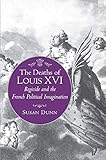The Deaths of Louis XVI : Regicide and the French Political Imagination / Susan Dunn.
Material type: TextSeries: Literature in History ; 3Publisher: Princeton, NJ : Princeton University Press, [2022]Copyright date: ©1994Description: 1 online resource (195 p.)Content type:
TextSeries: Literature in History ; 3Publisher: Princeton, NJ : Princeton University Press, [2022]Copyright date: ©1994Description: 1 online resource (195 p.)Content type: - 9780691224916
- Historians -- France -- Political and social views
- Kings and rulers in literature
- Monarchy -- France -- Public opinion
- Public opinion -- France -- History -- 19th century
- Regicide -- Public opinion
- Regicides -- Public opinion
- HISTORY / Europe / France
- American Civil War
- American Revolution
- American amnesty
- Belgians
- Blanc, Louis
- Bourbon dynasty
- Buchez, Philippe
- Charles VII
- Dreyfus affair
- English readers
- Enlightenment
- Franco-Prussian War
- German fascism
- German war criminals
- Grenoble conspiracy
- Hebrew Bible
- Indian mythology
- Jesus Christ
- Judaism
- Koestler, Arthur
- Lakanal, Joseph
- Marie-Antoinette
- Napoleon I
- Nazism
- Old Testament
- abdication
- capitalism
- chosen people concept
- citizenship
- civic virtue
- civil disobedience
- collaborationists
- collective emotion
- democracy
- division of labor
- emancipation of slaves
- executioners
- expediency
- extremist ideologies
- fascism
- father figures
- financial power
- forgiveness
- fraternity
- genius
- historiography
- human rights
- impeachment trials
- liberalism
- material prosperity
- miracles
- passive resistance
- DC137.08
- online - DeGruyter
| Item type | Current library | Call number | URL | Status | Notes | Barcode | |
|---|---|---|---|---|---|---|---|
 eBook
eBook
|
Biblioteca "Angelicum" Pont. Univ. S.Tommaso d'Aquino Nuvola online | online - DeGruyter (Browse shelf(Opens below)) | Online access | Not for loan (Accesso limitato) | Accesso per gli utenti autorizzati / Access for authorized users | (dgr)9780691224916 |
Frontmatter -- CONTENTS -- FOREWORD -- ACKNOWLEDGMENTS -- INTRODUCTION -- PART I POLITICAL MYTHS -- Chapter One LOUIS XVI AND THE CULT OF HUMAN SACRIFICE -- Chapter Two LOUIS XVI AND JOAN OF ARC -- Chapter Three MICHELET AND LAMARTINE: REGICIDE, PASSION, AND COMPASSION -- PART II LITERARY MYTHS -- Chapter Four LOUIS XVI AND HIS EXECUTIONERS -- Chapter Five VICTOR HUGO, KINGSHIP, AND LOUIS XVI -- Chapter Six CAMUS AND LOUIS XVI: A MODERN ELEGY FOR THE MARTYRED KING -- CONCLUSION -- INDEX
restricted access online access with authorization star
http://purl.org/coar/access_right/c_16ec
The public beheading of Louis XVI was a unique and troubling event that scarred French collective memory for two centuries. To Jacobins, the king's decapitation was the people's coronation. To royalists, it was deicide. Nineteenth-century historians considered it an alarming miscalculation, a symbol of the Terror and the moral bankruptcy of the Revolution. By the twentieth century, Camus judged that the killing stood at the "crux of our contemporary history." In this book, Susan Dunn investigates the regicide's pivotal role in French intellectual history and political mythology. She examines how thinkers on the right and left repudiated regicide and terror, while articulating a compassionate, humanitarian vision, which became the moral basis for the modern French nation. Their credo of fraternity and unity, however, strangely depoliticized this supremely political act of regicide. Using theoretical insights from Tocqueville, Arendt, Rawls, Walzer, and others, Dunn explores the transformation of violent regicidal politics into an apolitical cult of ethical purity and an antidemocratic nationalist religion. Her book focuses on the fluidity of political myths. The figure of Louis XVI was transmuted into a Joan of Arc and a deified nation, and the notion of his sacrifice contributed to the disquieting myth of a mystical community of self- sacrificing citizens.
Mode of access: Internet via World Wide Web.
In English.
Description based on online resource; title from PDF title page (publisher's Web site, viewed 29. Jul 2022)


